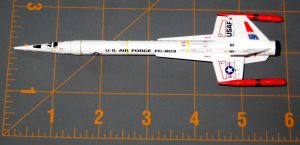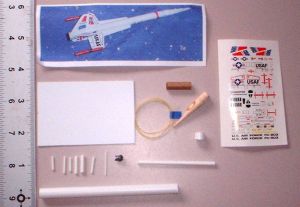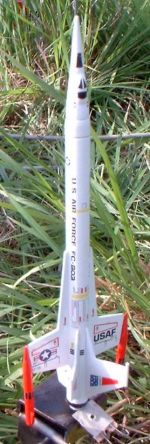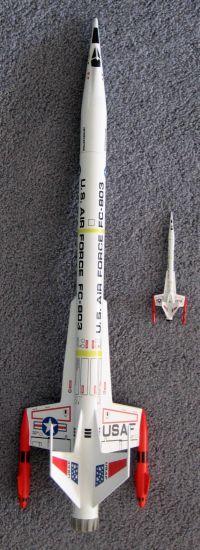| Construction Rating: | starstarstarstar_borderstar_border |
| Flight Rating: | starstarstarstarstar |
| Overall Rating: | starstarstarstarstar_border |
| Manufacturer: | Micro Classics |
| Style: | Downscale, MicroMaxx |

Brief:
Micro Classics kits are a little hard to find, but are worth the effort looking
for them. This is an approximate 1/5 scale version of the Estes K-50
Interceptor. Having built a clone of the K-50 a couple years ago, I was
intrigued by the opportunity to build a tiny version.
Construction:
All tubing and fins are plastic with a nose cone that appears to be hardwood.
The cuts on the tubing weren't quite square but are easily corrected. The nose
cone even has a little glob of resin to replicate the cockpit from the
original. Parts included in the baggy include:

- Nose cone
- 8mm short tube
- 8mm body tube
- Styrene fin stock
- Cardboard tube coupler
- Assorted trim tubing
- Kevlar® shock cord
- Mylar streamer
- Waterslide decals (you'll need a magnifying glass to read them)
The instructions for this kit were pretty crude with a few hand drawn illustrations. They were fairly well written although with all the different tube sizes and lengths, it was a bit confusing making sure I was working with the right material. There is a sketch of an exploded view/parts list on the last page, which is critical for identifying parts throughout the process. Keep that page face up and handy on your table as you build.
Construction begins by cutting the fins and assorted tubes to length. This is easily done for the fins by scoring the lines then breaking the material along those lines. A little 220 grit sandpaper to clean up the edge and you're good to go.
The original K-50 has a molded plastic tail cone. This is imitated (roughly) in this kit by sanding a taper to the end of the body tube. Since the plastic tubing is not very thick walled, this is a bit tricky so you'll need to be careful. The finished result, especially when painted black, is pretty sharp and looks a good deal like the original.
Assembling the plastic bits requires a good glue. I highly recommend liquid plastic cement--the kind you brush on from a bottle not the squeeze tube stuff. It goes on cleanly, leaves virtually no residue, and bonds extremely well. It also sets quickly. For a micro sized kit like this, where a fillet might be almost as large as the launch lug, clean, sharp bond lines are essential.
The wing pods from the original are crudely imitated by cementing solid plastic dowels inside some pretty small tubing then sanding down the seam to a taper. You then finish them off by tacking on a pair of tail fins (and good luck cutting them--I could barely even hold them with a pair of tweezers!) The finished product does look pod-like, but the fit along the edge of the main fins is not as clean as the original sized kit. Still this is a micro scale kit, so some concessions are in order.
The rest of the assembly moves fairly quickly, mainly just tacking on the assorted fins, tail wings, etc. There are 6 total fins/wings on the main body tube with a hand drawn wraparound marking guide used for alignment.
I found the nose cone assembly a bit of a challenge because the cone is not quite the same OD as the body tube. There is a short length of tubing used as a transition instead. This must be sanded down to a taper. That part wasn't too tough, but I goofed and glued it to the nose cone shoulder. That left me with only about 1/16" exposed shoulder on the nose cone, which doesn't hold the cone in the body tube very well.
What you're supposed to do, if you're paying close attention to the directions, is drill a hole in the shoulder to bond the Kevlar® cord, tie the cord around a lead sinker for nose weight (supplied), wedge the sinker into a tube coupler, and glue the transition around the coupler, which is aligned with the base of the nose cone. I was able to salvage my earlier goof by using a bit of Fix-It epoxy clay and building up my shoulder a bit and anchored the coupler to the clay before it cured.


Finishing:
To me, the K-50 Interceptor is one of the most beautiful rocket kits I've ever
seen. It's all about the wing pods, tail cone, funky nose cone, and very cool
decals. I was absolutely delighted to see that this kit included waterslide
decals made by Excelsior Rocketry. These decals are superb quality. Not only
was the ink/material/printing top notch, but the scale was incredible! I
expected these would be scanned copies of the originals, printed down to 20%,
which would make the lettering look smudgy and some of the smaller words not
even legible. That is not so. If you pull out a magnifying glass, you'll be
able to pick out the "rescue" and "caution" labels along
the fuselage. The lines were absolutely crisp. The decals alone are probably
worth the $12 price of this kit.
Painting this was pretty simple as with the plastic there are no grains or spirals to fill. I applied a single misting of white primer (and prior to construction I had washed all of the plastic parts with a mild liquid detergent). I then followed up with two thin coats of Rustoleum gloss white. I hand painted the pods orange and the tail cone gloss black.
Total construction and painting time ran about 4 hours. I then sat down to apply the decals. There are a lot of them, they are microscopic in size, and must be handled very delicately. That's the only negative I could ever say about Excelsior decals--they're fragile and you must read and follow the directions or you'll have runs, tears, and a mangled mess of decals. I pre-treated the decal sheet with a Microscale decal setting solution. I then coated the model with a Microscale setting solution, cut out one decal at a time, soaked it for 10 seconds, and dried it on a paper towel for about 30 seconds. At that point, the decal will slide off the paper fairly well, but you must place it correctly right off the bat as these don't like to slide around without tearing.
After all the decals were in place, I brushed on a third Microscale product that helps coat the decals (it also softens them so there is absolutely no chance of attempting to move them again). I finished it off by brushing on a coat of Future Floor Polish for gloss and durability.
The decals and clear coat took me a total of 5 hours, surpassing the construction and paint time, but were well worth the effort. The decals make this a fantastic looking miniature K-50 and every decal from the original has wound up somewhere on my micro version.
Construction Rating: 3 out of 5

Flight:
You're limited to MMX motors for this rocket obviously. I prepped it with a
tiny bit of dog barf, packed in the streamer, and slipped on the nose.
At the pad, this rocket clearly drew the most attention of anything I flew that day. Lots of "wow" factor with this. For a special treat, I flew my North Coast Interceptor G, followed by my full scale K-50 Interceptor, and for a finale concluded with this micro version.
At 0.3 ounces, you won't get much altitude, even compared to other micros. It zipped off the rod at a slight angle, peaked at about 60 feet, and as it was arching over, the streamer deployed. Very nice flight.
Recovery:
The streamer is more for effect than for drag, so doesn't offer much benefit.
Still, this floated gently down and landed in soft grass. It is in great shape
for another flight. I was especially glad that it didn't have any trouble in
the 8-10 mph winds.
Flight Rating: 5 out of 5
Summary:
This is an absolutely amazing, incredibly detailed rendering of the K-50
Interceptor. If you're looking for a great little MMX flyer, you can't beat
this. I've started building quite a few challenging micro designs, and this one
is head and shoulders ahead of most everything else I've got in that class.
Overall Rating: 4 out of 5
 |
 |
Flights
Sponsored Ads
 |
 |











